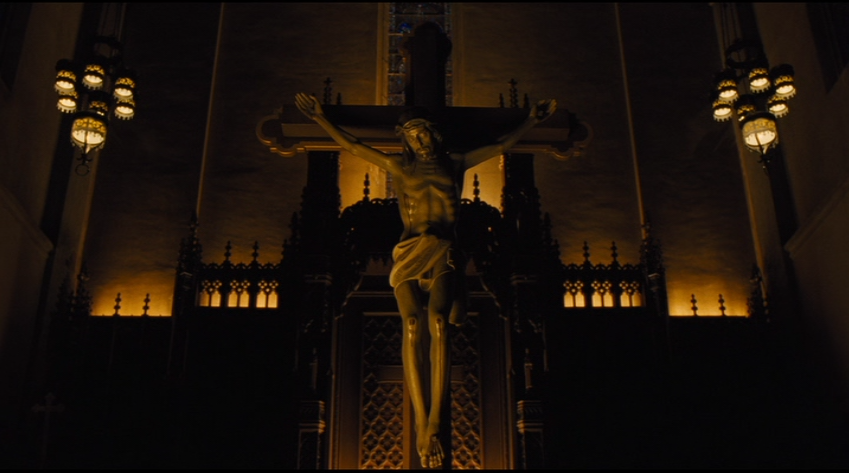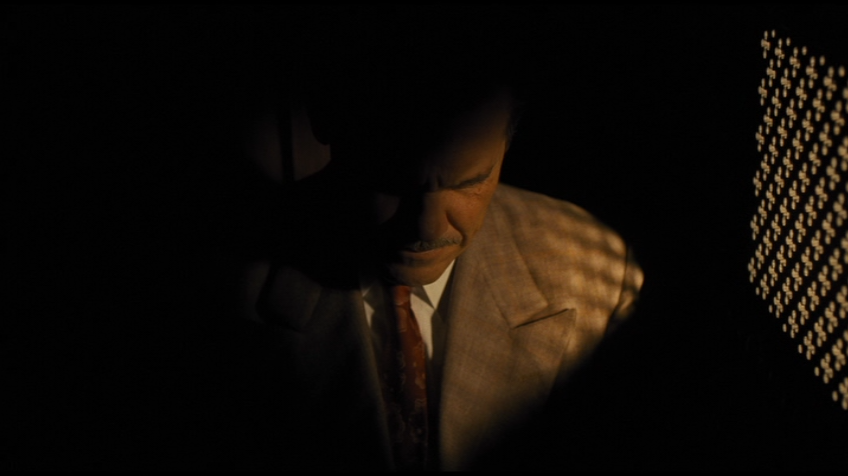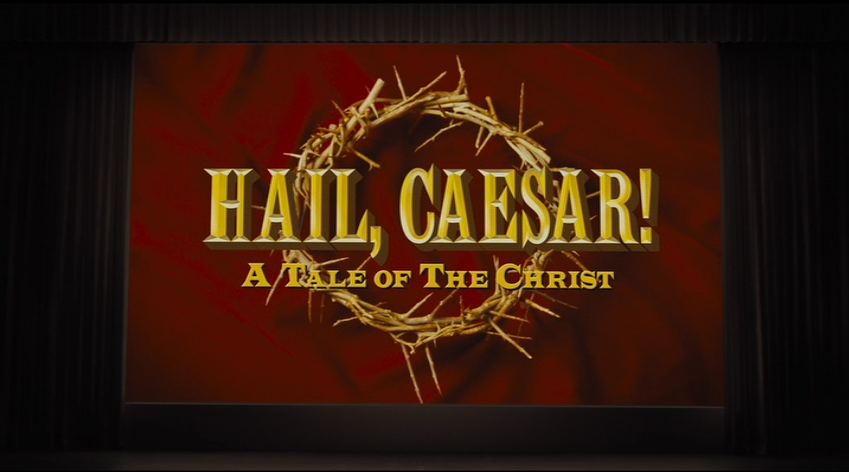Hail, Caesar! part 1
Hail, Caesar! begins with the image of a crucifix. This is imn portant to note, even before we know anything about the story, because it defines the poles of the narrative: the movie is titled Hail, Caesar! but Jesus is the opposite of Caesar. (As the gospels say,”Render unto Caesar the things that are Caesar’s, and unto God the things that are God’s.”) The movie, we will soon learn, is about a protagonist constantly running from Jesus to Caesar and back again, forever unsure about which one he’s serving.
All Coen Bros movies are, on one level or another, an examination of capitalism. There is always a character who represents “capital,” that is, the guy with all the money, and there is generally a character who represents “the little guy,” that is, the working Joe who’s just trying to get by. And the story of Jesus, as it happens, begins with the character who represents “capital” maybe more than any other in history, Caesar, raising taxes. Caesar raises taxes, which necessitates a census, which brings Joseph and his wife Mary from Nazareth to Bethlehem, and there’s no room at the inn because everyone is in town for the census. The boy who is born in a manger because of taxes eventually grows up to be a threat to Roman peace in Jerusalem. That’s the so-called “greatest story ever told,” and the protagonist of Hail, Caesar! is a storyteller.
So we meet our protagonist, Eddie Mannix, in a confession booth in his church. So Eddie is not only Christian, but Catholic. The important thing about being Catholic is that Eddie can, essentially, do anything he wants between confessions, sin as much as he likes, and receive absolution from a priest at his next confession. The first thing we hear Eddie say is that it’s been 24 hours since his last confession, which means either that he’s a very good Catholic or a very productive sinner. It’s also 4am, which means that Eddie is in the habit of giving confession around the clock.
But how sinful is Eddie? And how sinful does Eddie think he is? He confesses, tearfully, that he lied to his wife about the number of cigarettes he’s smoked in the past 24 hours (the number: 2, maybe 3). But a mere hour later, we see Eddie outside a house somewhere in the rainy LA night, checking up on an actress, Gloria DeLamour, who is shooting some “French postcards” with a seedy pornographer. Eddie is a studio “fixer,” the guy you call when you’ve got trouble, and in short order we see him drive off the pornographer, slap Gloria around, and pay the police to look the other way. But the only whiff of “guilt” we see on Eddie’s face is when he asks one of the cops “Can I bum a cigarette?” So obviously “sin” is a relative thing to Eddie. Obstructing justice to rescue a contract player from a porn shoot is just part of his job, but cigarettes, well, that’s a real vice.
The most important aspect of Eddie’s character is that he is, to my knowledge, the first studio executive in history to be portrayed as something other than a soulless, conniving egotist. Eddie works hard — really hard, pulling 27-hour days — to keep his studio running, and in spite of all the problems he faces he still strives to do better, wants to make good movies, wants to keep everyone happy and wants, most of all, to be forgiven by God.
As the narrator of Hail, Caesar! hints, Eddie’s life is defined by the stories he chooses to tell. He tells one such story to the cops, saying that the actress is a girl from the Midwest who is on her way home from a costume party, and he tells a number of other stories — much bigger, grander stories — in his capacity of studio executive. One of the principles, we will see, of Eddie’s life is that people prefer stories to reality. Some stories edify and raise the human spirit and some distract from worldly concerns: gossamer, nonsensical dreams concocted by a machine to relieve people of their money in exchange for a few moments of bliss. One question that Hail, Caesar! asks is, perhaps, are stories an addiction? Do we need stories the way Eddie needs cigarettes?
The biggest story Eddie wants to tell is Hail, Caesar! A Tale of the Christ, a Technicolor biblical epic that seems to fall somewhere between The Robe and Ben-Hur. We see the opening scene of Hail, Caesar!, which lays out the historical template for its story: The Romans control the world, and everyone suffers under their whips and are forced to worship Caesar. The narrator intones that there is “a new wind blowing from the east” in the form of Jesus, who will present a new paradigm of religious thought to the western world. The title card dissolves from the laurels of the Roman senate to Christ’s crown of thorns, to emphasize the dichotomy.
Hail, Caesar! (the movie within the movie) stars middle-aged leading-man Baird Whitlock as a Roman general of some sort who comes home to Rome from adventure abroad, driving slaves before him, and is sent to Jerusalem for reasons unknown, where he finds his life transformed by the mysterious Christ. We also see a scene depicting the inciting incident of the movie, where Saul of Tarsus is struck by a vision of God on the road to Damascus. So there are three principle characters in Hail, Caesar!: the Roman, Jesus, and Saul (who becomes Paul). Eddie, the executive making the movie, obviously identifies with one of those characters. Not Christ, certainly: that would be blasphemy. (In fact, one of the key aspects of the Jesus of both Hail, Caesar! and Hail, Caesar! A Tale of the Christ is that both movies shy away from depicting the deity at all.) No, Eddie sees himself as the Roman general, the man working for Caesar, oppressing the world under Caesar’s might but primed for redemption at the feet of Jesus. Saul, on the other hand, the merchant who has the vision, will turn out to have a different analogue later in the movie.
If Eddie Mannix is the Roman general, who is Caesar? That would be Nick Schenck, pronounced “skank,” Eddie’s boss in New York. Like Jesus, Mr. Schenck is never seen or even heard by the audience, he is merely silence at the other end of a phone. Mr. Schenck, like God perhaps, issues orders that Eddie doesn’t understand but must comply with. In this case, he demands that Hobie Doyle, a singing cowboy star, be placed in the lead of a sophisticated drawing-room comedy titled Merrily We Dance. If the parallel between Caesar and Mr. Schenck isn’t clear enough, the name of the studio is Capitol Pictures, which makes Mr. Schenck “capital” in the economic narrative of Hail, Caesar!, the guy who calls the shots and controls the narrative.



Excellent! If there was a movie I would want you to examine, it would be this one.
Also, have you seen “Hunt for the Wilderpeople,” the New Zealand film with Sam Neill in it?
I haven’t actually seen this film, but I’m delighted to get another analysis from you!